Head-Starting Burrowing Owls for a Wild Future
July 21, 2025
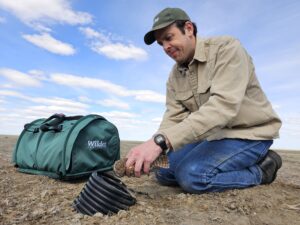
We sat down with Graham Dixon-MacCallum, a Conservation Research Population Ecologist at the Wilder Institute who leads our burrowing owl head-starting conservation program.
Burrowing owls are small, long-legged owls that nest exclusively underground. Rather than digging their own homes, they take over pre-existing burrows made by other prairie species such as badgers, ground squirrels, swift foxes, coyotes, and prairie dogs. Once commonly found across the Canadian prairie, burrowing owls are listed as an Endangered species under Canada’s Species at Risk Act.
Since 2016, the Wilder Institute has been working to support burrowing owl recovery through a technique called head-starting. This conservation method involves caring for wild animals during a vulnerable period of their life cycle—one they are unlikely to survive on their own—and releasing them back into the wild once they’re more likely to thrive. For burrowing owls, this means bringing juveniles into human care for their first winter, then releasing them the following spring as adults. The approach boosts survival rates, supports reproductive success, and provides valuable data to inform long-term conservation strategies. It also opens the door to community engagement and environmental stewardship. Graham has been involved with our burrowing owl program since 2017, and during that time, has helped release over 171 head-started owls back onto the Canadian prairies.
In this Q&A, Graham shares his experiences from the field and offers a behind-the-scenes look at the Wilder Institute’s efforts to safeguard this remarkable species.
Question: What initially drew you to work with burrowing owls?
“I was drawn to working with burrowing owls through a love for the prairies. In high school in Nova Scotia, I was very interested in wildlife biology and had the idea that I wanted to work for Parks Canada one day. I had read about Grasslands National Park in southern Saskatchewan and was hooked on the idea of working on the prairies. Years later I heard about an internship in the Wilder Institute’s Conservation & Science department during which I’d spend six months working in Grasslands and was lucky enough to get the job. During that internship, a permanent position opened working with burrowing owls—another prairie species. I had already gained experience working with birds in other parts of Canada, so I got the job, and I’ve been here ever since!”
Question: What’s one memorable moment from the field that has stuck with you?
“There have been so many memorable moments, it’s hard to choose just one. In general, doing fieldwork in the prairie wilderness of CFB Suffield is very special. The base is huge; it’s nearly half this size of PEI which makes it larger than many of Canada’s National Parks. Despite being so big, in recent years there are very few people who spend time out there. There are parts of the base where there are no fences or power lines or other signs of people visible in any direction, despite being able to see a very long way. In July we’re often out trapping owls late at night on the base and knowing that our little field team are the only people in 2700 square kilometers of prairie is an amazing experience.”
Question: What’s one thing you wish more people knew about the work our team does with burrowing owls?
“I can’t overstate the importance that landowners and leaseholders have in our program. Without them, there would be no burrowing owl head-starting because we wouldn’t have anywhere to release the owls. Burrowing owls are typically found in areas with short grass, like pastures, so cattle ranching is part of the reason owls have persisted in the areas where we work. I’ve really enjoyed getting to know ranching families around Suffield as we’ve done this work, and people may not realize how much they contribute to this work.”
A Peek Inside the Annual Release Process
As winter gives way to spring, the Animal Care, Health & Welfare, and Conservation Science teams begin preparing for the owls’ return to the wild. This year’s cohort included 26 owls—13 males and 13 females.
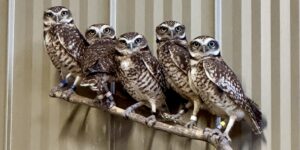
Five of the 26 burrowing owls in this year’s head-starting program cohort at the Archibald Biodiversity Centre (ABC).
The release process takes place over three days, with different groups of owls released each day. Preparations for release start weeks in advance when 20 are fitted with small, backpack-style satellite transmitters to allow for post-release tracking. This technology offers valuable insights into their movements and their annual migration journey.
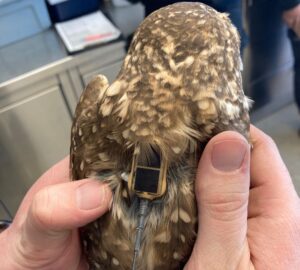
Burrowing owl with newly added transmitter. Photo by: Doug Whiteside
Pairs of owls are placed into divided transport carriers and loaded into a vehicle by the animal care team, who wave them off as the conservation team heads out for the next stage of their journey: a two-and-a-half-hour drive to the field house.
There, the team confirms each owl’s ID, checks their transmitters, and attaches alpha-numeric ID bands that allow individual birds to be identified from a distance using binoculars or spotting scopes. These are used alongside uniquely numbered bands issued by the Canadian Wildlife Service.
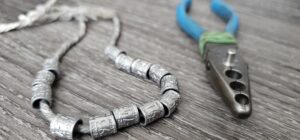
Using special banding pliers, owls are equipped with a band so the bird can be more easily identified and monitored.
Once banded and ready, the owls are brought to their release sites—each pair placed in an artificial nest burrow with a temporary enclosure. This soft release method offers protection from predators and gives the owls time to adjust to their new home. During this time, they receive food and are monitored via remote cameras. The enclosures are removed once the owls begin laying eggs—usually 1–2 weeks after release—marking their full return to the wild.
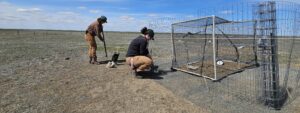
Adjusting the soft release enclosure which protects the owls while they get used to their new wild home.
Looking Ahead
We’re seeing promising results — but there’s still more to do. Head-starting is just one piece of a much larger conservation puzzle. Long-term success depends on continued collaboration—with landowners, governments, and conservation partners across provinces and even countries.
Your support can make a real difference—helping ensure species like the burrowing owl remain part of the vibrant prairie landscape we all cherish. Together, we can help secure a future for burrowing owls on the prairies.
